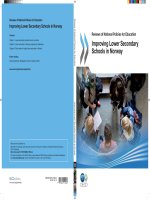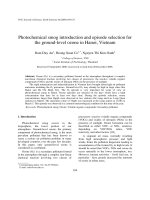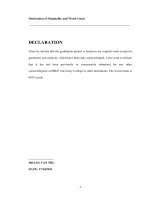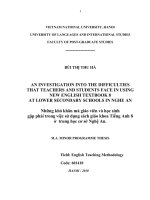DSpace at VNU: Education Policy Formation for School Improvement Practices at Lower Secondary Level in Hanoi, Vietnam - New Quality Issue after the Law on Residence in 2006
Bạn đang xem bản rút gọn của tài liệu. Xem và tải ngay bản đầy đủ của tài liệu tại đây (247.29 KB, 7 trang )
VNU Journal of Science, Vol. 32, No. 1S (2016) 158-164
Education Policy Formation for School Improvement
Practices at Lower Secondary Level in Hanoi, Vietnam - New
Quality Issue after the Law on Residence in 2006
Tatsuya Kusakabe*
Hiroshima University, Japan
Received 06 October 2016
Revised 18 October 2016; Accepted 28 November 2016
Abstract: This study investigates the Vietnam government and Hanoi local governing body’s
efforts to improve lower secondary education after the law on Residence in 2006. The law on
Residence adopted by the National Assembly of Vietnam in 2006 ensures the freedom of
temporary residence and relaxes the rule for shifting to permanent registration. The enforcement of
the law in 2007 made Hanoi population increase from 3,751,000 (2000) to 5,276,000 (2015) and
caused a bloated lower secondary education. The researcher conducted the field research twice in
both central and rural areas of Hanoi from December 13, 2013 to December 25, 2013 and from
December 27, 2014 to January 2, 2015. The research data were obtained from interviews and
documents collected from teachers, city education officers and other researchers. The research
outcome shows three points. First, improvement policies rely on teacher competition and
community donation due to lack of budget in the public sector. The policies are enforced in both
central and rural areas. Second, the children of migrants to Hanoi were refused from top level
public schools in central Hanoi despite of the improvement policies. Moreover, rich households
were sending their children to expensive private English medium schools which had recently been
established. Third, the improvement policies, on the one hand, gave a better impact on the quality
of education in top level schools in central Hanoi; but on the other hand, they lost their substance
in rural Hanoi.
Keywords: Education policy, school improvement, lower secondary level, Hanoi, residence law.
1. Problem statement
field but also to various fields. For example, the
Doi Moi were including the change of
household registration regime, because peoples’
freedom of movement from an outside to Hanoi
city and Ho Chi Minh city were limited before
the policy. Such a limitation of freedom of
movement was one of the shackles for
economic development. This recognition lead
that the National Assembly of Vietnam adopted
the law on Residence in 2006 which ensured
the freedom of temporary residence and the
This study tries to investigate how the
Vietnam government and Hanoi local
governing body have been tried to improve
quality of lower secondary education after the
law on Residence in 2006.
From 1986, the Doi Moi policy has
undertaken mainly in economy field. Although
this policy influenced not only to economic
_______
Email:
158
158
T. Kusakabe / VNU Journal of Science, Vol. 32, No. 1S (2016) 158-164
relaxation of the rule of shifting permanent
registration.
Hanoi citizen increased from 3,751,000
(2000) to 5,276,000 (2015) due to the
enforcement of the law in 2007. The
enforcement of the law resulted the emergence
of the bloated lower secondary education.
Logically, those increasing of number of
students in schools in Hanoi invited decline of
quality of education. And there has been no
study that tried to analyze such a balance
change due to increasing the number of students
from outside of Hanoi. That’s why, this study
tackles following two research questions.
(1) How the government and schools
responded above critical situation in education
as a result of dilemma between population
increasing and quality decreasing?
(2) Particularly, how those policies and
practices effected to school or classroom level
activities?
Throughout
investigation
of
above
questions, I’d like to depict Vietnamese
characteristics of its school improvement style.
Moreover, for theoretical and practical
contribution, this study adopts an internal
comparative analysis between semi-urban
setting and urban setting, because the
phenomena itself is observed in some other
developing countries. In particular, the
comparison between Hanoi city and Hun Yen
district. The reason why I adopt this internal
comparative methodology is that there must be
huge gap between a capital city and a peripheral
area. Throughout this comparative analysis, we
could be recognized problematic situation in a
peripheral area and policy recommendations for
the area clearly. The analysis also includes
some suggestions to school improvement
practices in other developing countries where
are struggling with same type of dilemma
between population increasing and quality
decreasing. Already the author discussed as for
the education issue in Vietnam aftermath of the
law on Residence 2006(Kusakabe 2015). In the
context of school improvement, there is a case
159
study of from the perspective of lesson study
for learning community (Saito et al. 2008,
2010, 2011).
2. Methodology of field work: The interview
research to educators as for the situation of
increasing tendency of students and
decreasing tendency of quality of education
The research methodology is formulated
mainly by field work for responding to above
two research questions. The research works
were conducted in central Hanoi and one of the
rural area of Hun Yen district on 13th Dec 201325th Dec 2013, and 27th Dec 2014-2nd Jan 2015.
The author did interview research and
documents collection from secondary school
teachers, city education officers and
researchers. For translation from Vietnamese to
English and also to discuss about interpretation
of interview result, I accompanied an associate
professor of Vietnam National University,
Hanoi (VNU, Hanoi) in the research work.
First, the interview research focused on how
the principals or head teachers at ten secondary
schools are recognizing recent increasing
tendency the number of students to know about
influence of the law on Residence in 2006. As
mentioned, it was possible to have a hypothesis
that the quality of education may be declined
due to lack of number of teachers and their skill
to educate increased students logically. The
research focused on how the policy makers and
schools responded the situation of increasing
tendency of students and decreasing tendency
of quality of education. Additionally, the
research got some cooperation for considering
and getting insights from Prof. Phạm Thị Thanh
Hải of Vietnam National University, Hanoi.
Second, a class room observation was
conducted during research period. I checked
class room environment include teaching
materials and equipment such as PC, projector,
TV and so on. Then, also checked teachers’
teaching style, speaking speed and level of contents.
160
T. Kusakabe / VNU Journal of Science, Vol. 32, No. 1S (2016) 158-164
Photo1. Secondary class room in Hanoi.
Photo2. Secondary class room in Hung Yen.
Later, I confirmed their rating of the class with
professors of VNU, Hanoi.
Third, I interviewed local education officers
to know about their recognition of the status
quo in secondary school education and
education improvement policies for them.
Additionally, I collected documents and books
of the schools, policies and general knowledge
of Vietnam education.
3. Law on Residence 2006
Vietnam has the citizen registration system
calling as “ho khau thuong tru”. Ministry of
Police is in charge of the registration. The
system has been worked within the country
from 1955. In the system, the people who
registered the system had a proof to get
governmental services such as education, health
care, financial loan and so on. On the other, the
system required if once they shifted to other
place as a temporary resident, must be lost the
right to access to social services. Due to the
requirement, many people were in difficulty to
transfer to other place for working at once.
However in November 2006, Law on
Residence 2006 was amended and started to
allow temporary residence in Hanoi without
any time frame. This law aimed to use the
people for vibrant economy as work force who
transferred from outside of Ha Noi or Ho Chi
Minh. Although, the “ho khau thuong tru” was
remained and the system is still a proof to get
social and medical services. Even after the law,
following four categories have remained which
means that people in lower categories cannot
get social services.
KT1: KT1 citizen means a resident
(including both non-migrant and migrant) with
permanent household registration at place of
current residence. The KT1 citizen could be
purchased and sold land and housing and have
land/house ownership certificates, and have
accessibility to public facilities and social
services,
formal
financial
loans
and
employment at current place of residence. On
the other hand, there are obstacles that KT1
people could be access to public social services
including education and health care only within
their district of residence
KT2: KT2 citizen means an intra-district
migrant who have permanent household
registration in the province/city of current
residence. The KT2 citizen could be purchased
and sold land and housing and have land/house
ownership certificates as same as KT1.
Furthermore, KT2 people could be access to
public
facilities,
social
services
and
employment. As same as KT1, there are same
obstacles that education and health care only
within the district where they are registered.
Additionally, there are lack of access to
financial loans/formal financial services in KT2
category.
KT3: KT3 citizen means a migrant who do
not have permanent registration at the place of
T. Kusakabe / VNU Journal of Science, Vol. 32, No. 1S (2016) 158-164
current residence but have temporary
registration for 6-12 months with the possibility
of extension. KT3 people have access to public
facilities and social services. However there is
lack of access to legal housing. KT3 children
could be accessed public schools only when the
schools have enough capacity, it means if KT1
and KT2 children. If the schools are
overcrowded, KT3 children have to go to
private schools, where they have to pay higher
school fees. As same as KT2, there are lack of
access to financial loans/formal financial services.
KT4: KT4 citizen means a migrant who do
not have permanent registration at their place of
current residence, but have temporary
registration for 1-6 months. Their disadvantages
are lack of the right to purchase land and access
to public social services and financial loans.
Non-registered residents: This means that
those who do not belong to any of the above
category. They do not have the right to
purchase land and access to public social
services and financial loans.
Particularly, KT3, KT4 and Non-registered
residents in Ha Noi have disadvantage even
after the law in terms of social services.
However so many people tried to enter to the
schools in Ha Noi. Those situation resulted
severe quality deterioration in education due to
more children registered as students. For this
situation Ha Noi municipality couldn’t respond
those disruption include quality deterioration
because of wider area and larger population
than before.
4. Overcrowded class room in Ha Noi schools
According to Doi Moi and Residential
Law 2006, Ha Noi city started socio-economic
transfiguration. Number of Ha Noi citizen
increased from 3,751,000 (2000) to 7,090,000
(2015) (GSOV 2016) due to the enforcement of
the law in 2007. Moreover, Ha Noi city area
expanded about 3.6 times bigger than before
2007 (3,324.5 km2) in 2008. In behind of the
161
migration policy reform, National Action Plan
Education for All (2003-2015) also been
developed the education system. EFA aimed to
create equal opportunities and quality education
for all children, to meet the basic learning needs
of every member of society. On the other hand,
the government couldn’t accelerate proliferation
of public schools which is based on a
financially sound proposal. Because each local
government couldn’t buy land for schools due
to rising land prices in Ha Noi.
That’s why, EFA created educational
disparities for everyone, enabling the
development of individuals and communities.
Particularly students who belong to K3
category rushed to public schools in Ha Noi
because they have the right to education in their
temporary resident place. The EFA and
enforcement of the Residential law 2006,
resulted the emergence of the bloated school
education system. Depends on the bloating
number of students, the richest class parents
demanded their own school system which is
carefully organized and established as English
medium education. Needless to say, they collect
huge amount of tuition fee from the parents.
Such movement of richer class in recent
Vietnam have been created top level private
schools.
During the top level private schools were
mushrooming recently, while top level public
schools and middle level public schools were
trying to keep their performance level. Many
K3 people wanted to send their children to
public schools after the law. However Top level
public and middle level public schools didn’t
accept their applications, their reason why that
were there are no capacity to accept
furthermore students. As a result of above
phenomena, K3 people rushed to normal level
public schools. Finally the new hierarchy of
school level were newly emerged in recent
Vietnam (Figure1).
In a sense of school improvement, it can be
understood as school improvement practices by
their self-purification ironically.
162
T. Kusakabe / VNU Journal of Science, Vol. 32, No. 1S (2016) 158-164
Figure 1. Transformation of hierarchy of school level in Hanoi city.
5. School improvement policies by the
government
The government include local level try to
improve school education. From primary to
secondary, teacher competition hold once a
year, it is divided in district level, province
level and national level. A several winners are
given little awards (certificate and small prize
money, less than 20USD). Winners of the
competition supposed to have hidden privileges
to choose elite school or test school as place of
work. Student competition or mathematics and
science Olympic hold once a year too. The
winners supposed to have a privilege of extra
points at entrance exam to higher secondary
schools. Additionally, school inspectors are
checking up four times a year within their
catchment area.
These competitions work for protecting
quality of education in the top level public
schools. Several winners could be get small
amount of money, but a true privilege is that
those winners would be given a priority when
they choose a next school. Needless to say
almost of winners try to choose top level public
schools. So those schools would be succeeded
high quality teachers in stable condition. In
other words, low level public schools cannot be
secured high quality teachers.
6. School improvement practices at lower
secondary level
The author visited several secondary
schools in Ha Noi and Hun Yen district to find
what the schools have good practices with
originality for school improvement. There are
commonality in terms of school improvement
practices because which lead by the guideline
of the government to some extent. First, they
were conducting “socialization” as donation
program in each school. For instance the
concept of “socialization” is donation to
schools from parents or a community. By this
donation, all of the target schools were
procuring air conditioner, fan, PC, interactive
white board, projector, extra salary to teachers
and other school facilities. Higher level schools
were well organized socialization, compared
with lower level. Second, the target schools
were formulating subject-specific groups within
a school. They have weekly or monthly meeting
for improvement.
Those common activities were working to
keep school quality, while some schools were
T. Kusakabe / VNU Journal of Science, Vol. 32, No. 1S (2016) 158-164
having some original activities. One school was
conducting utilization of retired teachers for
advising current teachers. And one school set
up the trial period to new teachers. In the
system, if a teacher are judged as less ability as
a teacher, he or she supposed to be fired. Also
some middle level schools were screening
children who came from outside Ha Noi,
whether they accept as students or not.
In individual level, many teachers in Ha
Noi were continuing their education study at
university. Basically Ha Noi people respect
dedication to learning, so each school
encourage teachers to get a degree for better
education. This opportunity motivated to
increase teachers’ professional identity.
The research results show us that three
points. First, improvement policies rely on
teacher competition and community donation
due to lack of the budget in public sector. The
policies are enforced both central and rural areas.
7. Comparative analysis between Ha Noi and
Hung Yen district
From comparative study between Ha Noi as
an urban setting and Hung Yen as a rural
setting, the enforced school improvement
activities such as the competition of teachers
and students and the socialization as donation
through school management committee,
functioned in mainly Ha Noi city area. In Hung
Yen also, the school improvement activities
were conducted too. However, the activities
didn’t well functioned in classroom level
compared with Ha Noi. Second, the children of
migrants from outside of Hanoi were refused
from top level public schools in central Ha Noi
in behind of the improvement policies.
Moreover, so far it was observed only in Ha
Noi that many richer households were sending
their children to expensive private English
medium schools which have been established
recently. Third, the improvement policies gave
163
better impact to the quality of education in top
level school in central Hanoi. On the other, the
policy lost its substance in the Hung Yen
district.
8. Conclusion
As a result of the research work, it can be
said the government tried to avoid school
improvement by education policy package such
as teacher competition and student competition
without using huge budget. As mentioned
above, the policy package mainly worked for
top level schools. The system was structured
that better teachers tend to go top level public
schools. And socialization worked well in top
level public too. Notably, top level schools
were screening K3 students at an entrance step.
Such school improvement system provided top
level schools comparatively stable education
environment.
On the other, many K3 students who
spoiled from top or middle level public schools,
rushed to low level schools in Ha Noi. Of
course those schools are joining some
competitions and conduct socialization, but its
performance was not very much because their
students were diversified as K1 to K3 students
and teacher student ratio expanded. In the sense
of school improvement, those low level public
school come up against such bloated inclusive
problem.
Furthermore,
according
to
above
comparative analysis, even there are many
students who shifted from outside of Ha Noi, it
seems like secondary schools in Hanoi have
advantage in terms of education environment
and teaching methodology.
In all over the analysis, the study found that
the top level and middle level schools were
successfully established to avoid decline of
their quality education. However low level
schools were bloating rapidly and had serious
inclusive problems.
164
T. Kusakabe / VNU Journal of Science, Vol. 32, No. 1S (2016) 158-164
References
[1] General Statistics Office of Vietnam (GSOV)
Website, />px?tabid=766, (accessed on 06. Mar. 2016)
[2] Kusakabe, T. (2015). 2006 nen kyojuhou ikou
no Hanoi shi ni okeru gakkou kaizen-seisaku
jissen no kenkyu - [School Improvement
Practices at Lower Secondary level in Hanoi,
Vietnam - New quality issue after the law on
Residence in 2006. Kokusai kyouiu kyouryoku
ronshu (Journal of International Cooperation in
Education. 18(1), 53-62. (In Japanese).
[3] Saito, E., & Tsukui, A. (2008). Challenge
common sense: Cases of school reform for
learning community under an international
cooperation project in Bac Giang Province,
Vietnam. International Journal of Educational
Development, 28(5), 571-584.
[4] Saito, E., Do, T.H., & Khong, T. D. H. (2010).
Echoing with the voices of victims: Reflection
on Vietnamese lessons on the Japanese
experiences of atomic bombs. Improving
Schools, 13(3), 221-234.
[5] Saito, E., Thi Dien., Khong, H. & Tsukui, A.
(2011). Why is school reform sustained even
after a project? A case study of Bac Giang
Province, Vietnam. Journal of Education
Change, 12, online publishing.
Xây dựng chính sách giáo dục cho các hoạt động cải thiện
trường trung học cơ sở (THCS) tại Hà Nội, Việt Nam - Vấn đề
mới về chất lượng sau luật cư trú ban hành năm 2006
Tatsuya Kusakabe
Đại học Hiroshima, Nhật Bản
Tóm tắt: Nghiên cứu nhằm tìm hiểu việc chính phủ Việt Nam và cơ quan quản lý Thành phố Hà
Nội thực hiện cải thiện trong giáo dục trung học cơ sở (THCS) sau khi ban hành Luật cư trú năm
2006. Chính sách đổi mới bao gồm sự thay đổi trong việc đăng ký hộ khẩu. Quốc hội Việt Nam đã
thông qua Luật Cư trú năm 2006 nhằm đảm bảo quyền tự do cư trú tạm thời và nới lỏng các quy tắc
trong việc chuyển đổi đăng ký thường trú. Dân số Hà Nội tăng từ 3.751.000 (2000) đến 5.276.000
(2015) do việc thi hành pháp luật vào năm 2007. Việc thi hành luật đã dẫn đến việc giáo dục trung học
cơ sở đã tăng đột biến. Các nhà nghiên cứu đã tiến hành nghiên cứu thực địa hai lần tại khu vực trung
tâm và nông thôn của Hà Nội vào ngày 13/12-15/12/2013, và ngày 27/ 12/2014 đến 01/01/2015. Các
nội dung nghiên cứu gồm nghiên cứu phỏng vấn và thu thập tài liệu từ các giáo viên, cán bộ giáo dục
thành phố và các nhà nghiên cứu. Các kết quả nghiên cứu cho thấy ba điểm. Thứ nhất, chính sách cải
thiện dựa trên cạnh tranh giáo viên và đóng góp cộng đồng do thiếu ngân sách trong lĩnh vực công.
Chính sách được thi hành ở cả khu vực trung tâm và nông thôn. Thứ hai, đằng sau các chính sách thì
trẻ em từ gia đình nhập cư bên ngoài Hà Nội đã bị từ chối tại các trường điểm (công lập) ở trung tâm
Hà Nội. Hơn nữa, các hộ gia đình có điều kiện gửi con đến trường tư thục học phí cao giảng dạy bằng
tiếng Anh, được thành lập gần đây. Thứ ba, các chính sách cải thiện đã tác động tốt hơn đến chất
lượng giáo dục ở trường điểm tại khu vực trung tâm Hà Nội. Mặt khác, chính sách bị mất căn bản ở
các vùng nông thôn ngoài Hà Nội.
Từ khóa: Chính sách giáo dục; cải thiện nhà trường; THCS; Hà Nội; luật cư trú.









